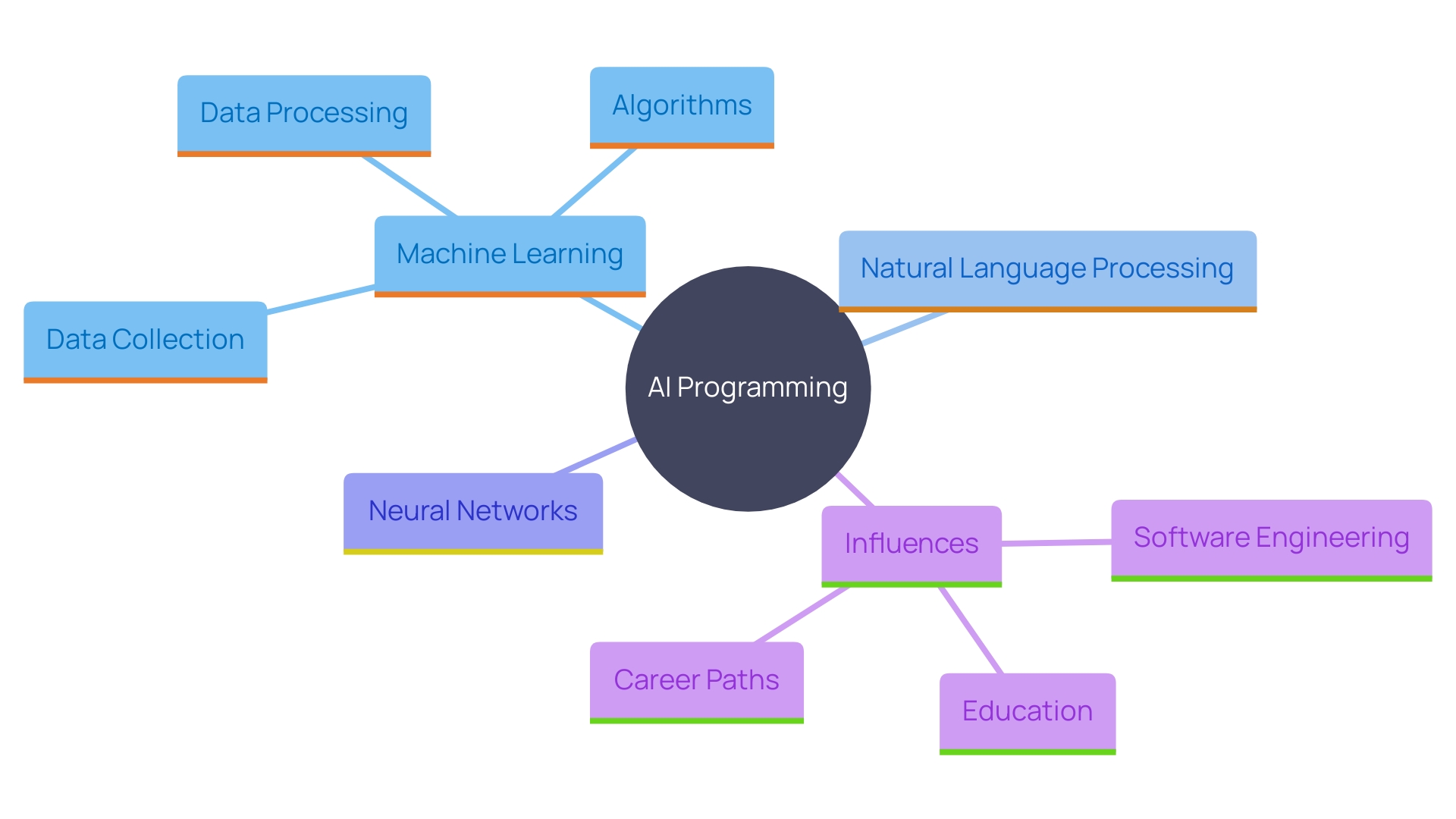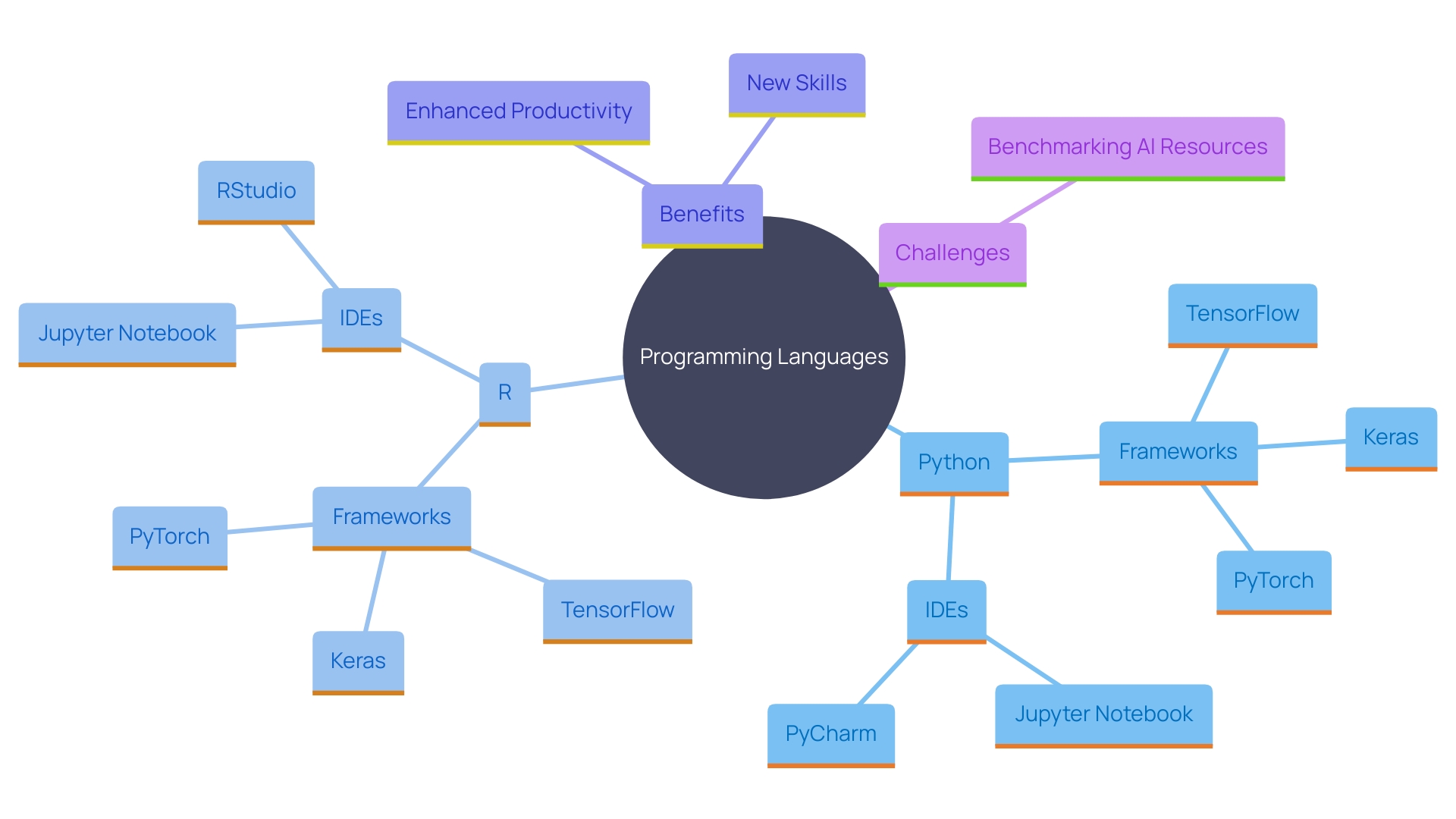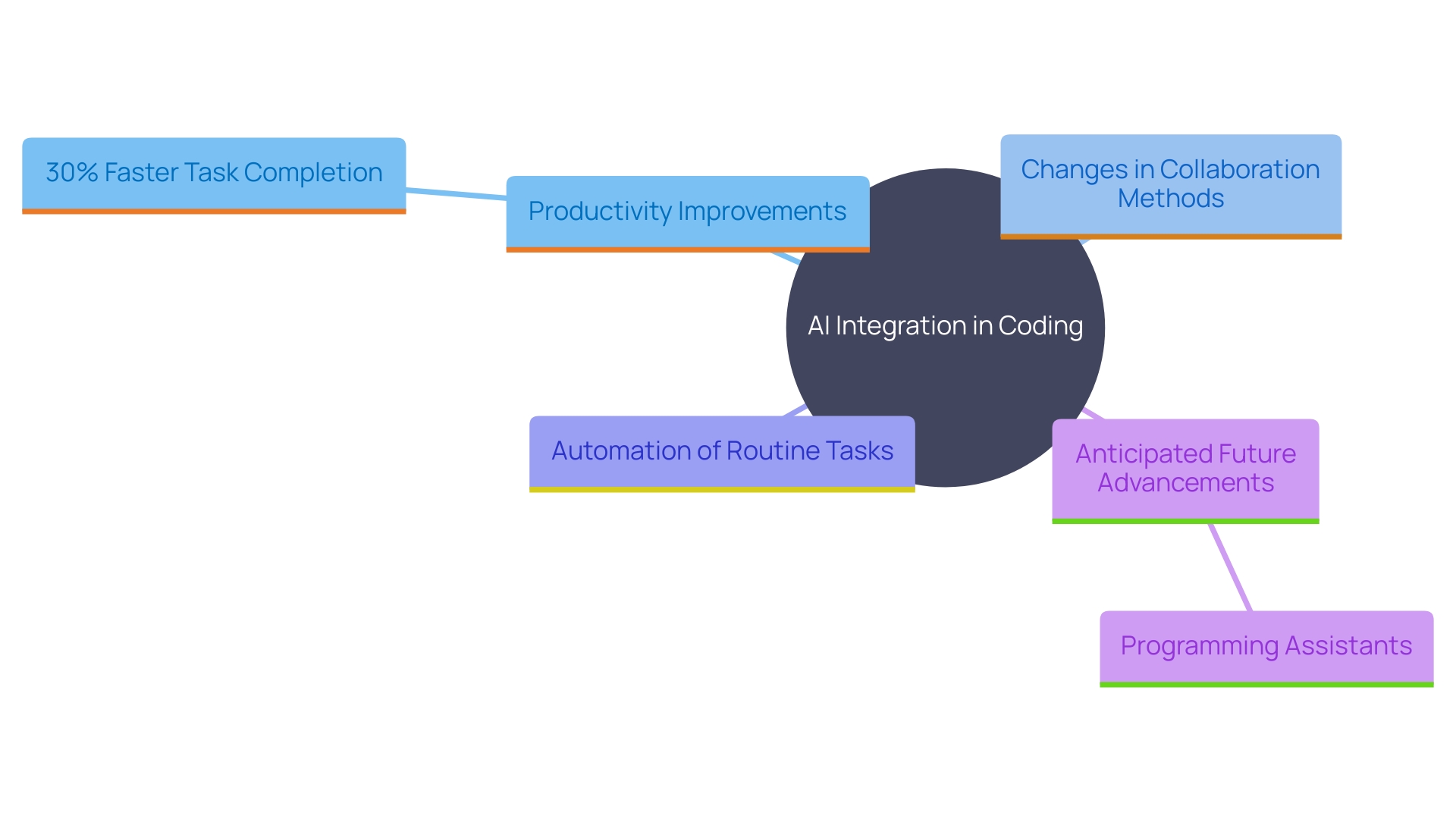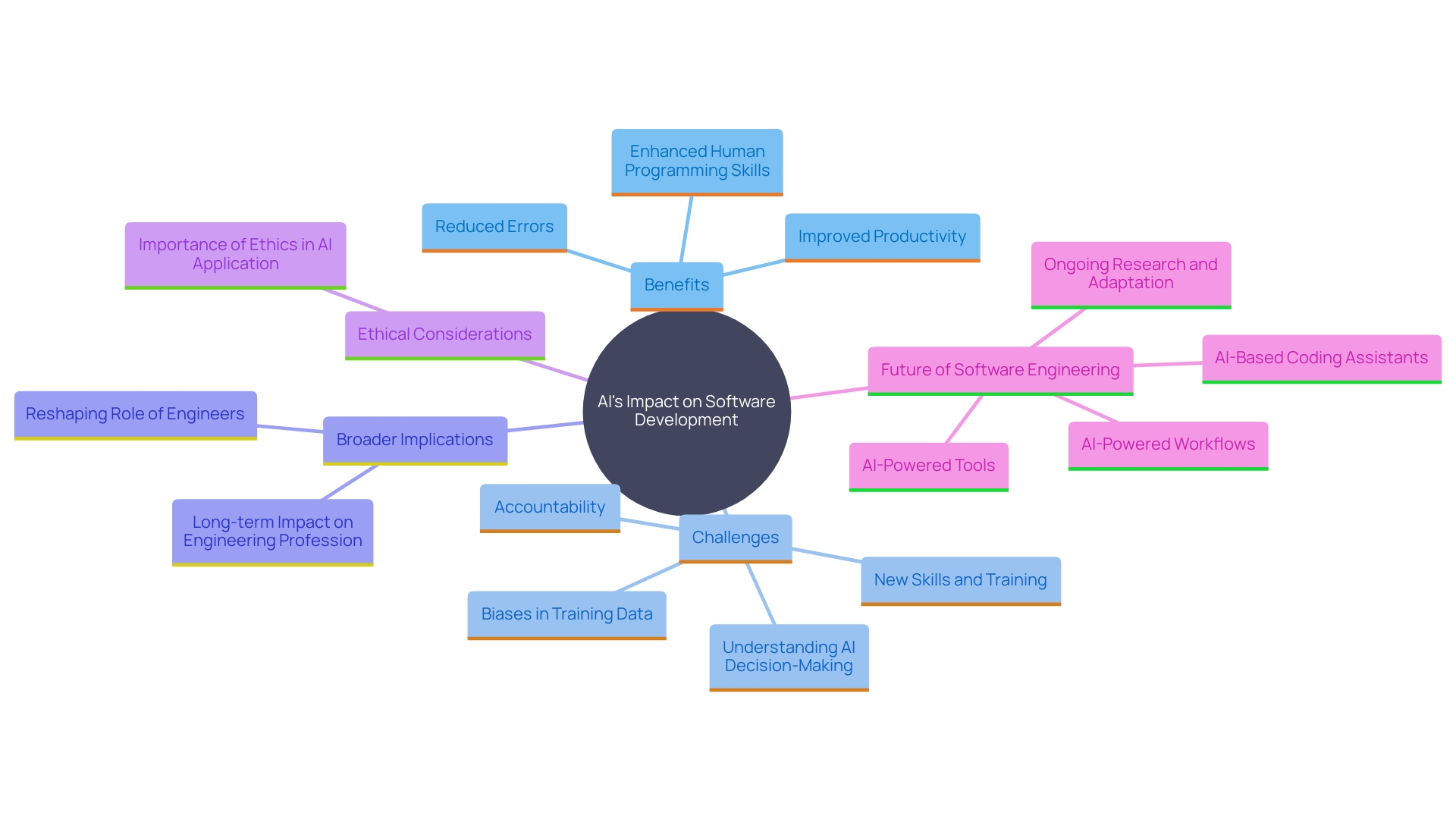Introduction
Artificial Intelligence (AI) coding is transforming the landscape of software development, offering unprecedented advancements in efficiency and productivity. By harnessing the power of machine learning, natural language processing, and neural networks, developers can create intelligent systems capable of learning and improving from data. This evolution is not just theoretical; tangible benefits are already being seen in various industries.
Google's AI-powered tools, for example, have accelerated software development tasks by 30%, showcasing the potential of AI to revolutionize coding practices. From supervised and unsupervised learning to reinforcement and deep learning, mastering these techniques equips developers with the tools to tackle complex challenges and innovate at a rapid pace. As AI continues to evolve, the integration of sophisticated tools and software will further streamline workflows, enhance collaboration, and redefine the future of software engineering.
However, this transformation is not without its challenges, including the need for transparency, ethical considerations, and the integration of human intuition with AI capabilities. By adhering to best practices and staying informed about the latest developments, developers can leverage AI to achieve new heights of efficiency and productivity in their coding endeavors.
Understanding AI Coding Basics
Artificial Intelligence (AI) programming enables machines to carry out activities that usually need human intellect, such as acquiring knowledge, reasoning, problem-solving, perception, and language comprehension. Rooted in mathematics, statistics, and computer science, AI coding leverages techniques like machine learning, natural language processing, and neural networks. These foundational elements are crucial for individuals aiming to build effective AI applications. As AI tools swiftly progress, their transformative influence on software engineering is clear, revolutionizing how programmers tackle problem-solving and efficiency. Machine intelligence, for example, enables systems to acquire knowledge and enhance automatically from experience, making data a critical asset. Understanding these technologies is essential, as the AI landscape continues to evolve, influencing primary and secondary education and redefining career paths in tech.

Essential Techniques for AI Coding
AI coding techniques have revolutionized how developers approach problem-solving and efficiency. Key methodologies include supervised teaching, unsupervised teaching, reinforcement teaching, and deep teaching.
Supervised training leverages labeled datasets to train models, enabling precise predictions and classifications. For example, Google's AI-driven resources have shown the capability to finish software development assignments 30% quicker by utilizing natural language code generation and smart code completion.
Unsupervised analysis, on the other hand, identifies patterns in unlabeled data, making it invaluable for exploratory data examination. This technique has supported breakthroughs in fields like bioengineering and climate forecasting, as AI tools uncover hidden structures within vast datasets.
Reinforcement training focuses on preparing models through trial and error, optimizing decisions over time. This approach has been pivotal in projects like Project Green Light, where AI models have improved traffic flow and reduced emissions in cities by up to 10%.
Deep neural networks are utilized to analyze intricate data structures, propelling progress in fields like computer vision and language translation. Google's Duet AI exemplifies this by aiding in programming, deployment, and cybersecurity threat resolution, showcasing how deep learning can enhance software engineering practices.
"Mastering these AI programming techniques enables creators to develop robust, efficient solutions customized for specific challenges, boosting productivity and innovation across various sectors.".

AI Coding Tools and Software
The landscape of AI programming tools is swiftly changing, providing creators a variety of powerful choices to enhance their workflows. Popular programming languages like Python and R are highly favored due to their extensive libraries and frameworks, including TensorFlow, Keras, and PyTorch. These frameworks come equipped with pre-built functions that significantly simplify the development of AI models, allowing developers to focus more on refining algorithms rather than building from scratch.
Integrated development environments (IDEs) like Jupyter Notebook and PyCharm further enhance productivity. Jupyter Notebooks, for instance, have seen a significant rise in use, with the number of Python 3 notebooks growing by 87% from 2019 to 2020. They are particularly popular for exploratory data analysis and prototyping models, with 42% of users employing them for such tasks. PyCharm offers a robust interface for coding and testing, making it easier to manage complex projects.
The influence of AI-driven resources extends beyond personal efficiency. Research indicates that these instruments are reshaping the engineering workspace, improving efficiency, and necessitating the acquisition of new skills. However, challenges persist, such as the need for improved benchmarks to assess AI resources across various software engineering tasks, including code migrations and production debugging.
In summary, the incorporation of AI resources in programming has already started to change the sector by automating repetitive activities, enhancing workflows, and aiding in code creation. Although AI is improbable to fully substitute human developers, individuals who utilize these sophisticated resources will discover themselves at a considerable benefit.

The Role of AI in Coding: Trends and Future
The integration of AI in coding is revolutionizing software development, making significant strides in productivity and efficiency. Recent studies have shown that teams utilizing AI-driven resources complete their tasks about 30% faster on average compared to those using traditional methods. This leap in productivity is due to the capabilities of AI resources like natural language code generation, automated testing, and intelligent code completion.
AI-powered applications are not only accelerating the process; they are also changing how programmers work together and oversee workflows. By automating routine tasks and providing real-time support, these tools free up developers to focus on more complex and creative aspects of their projects. This shift is expected to lead to major efficiency gains and cost savings across many industries.
As AI continues to evolve, we can anticipate even more advanced programming assistants that understand context and offer more nuanced support. This ongoing advancement underscores the transformative impact of AI on software engineering, signaling a future where development is faster, more efficient, and increasingly collaborative.

Challenges in AI Coding: Human vs. AI
While AI provides substantial advantages in software development, several challenges persist. One primary obstacle is the difficulty that human creators face in understanding Ai's decision-making processes, which raises concerns about accountability and transparency. This issue is critical, as highlighted by Erica Harper's insights on how AI can impact decision-making in high-stakes environments like military operations. Furthermore, biases in training data can lead to flawed AI outputs, thereby necessitating rigorous oversight and ethical considerations.
Balancing human intuition with AI capabilities is paramount to achieving optimal results without compromising ethical standards. A recent study on AI coding assistants emphasizes the importance of improving transparency and explainability to build trust among users. Additionally, AI resources should be designed to augment and empower developers rather than replace them, addressing ethical concerns around bias, privacy, and accountability.
Case studies reveal that while AI applications like AutoGPT show promise, they also have limitations. For instance, issues such as code execution failures and the need for human intervention to fix problems highlight the current shortcomings of AI in fully automating the programming process. Even with these obstacles, the capacity for AI to improve human programming skills remains substantial, as long as developers utilize these resources responsibly and professionally.

Best Practices for AI Coding
Implementing best practices in AI coding is crucial for achieving optimal results and staying current with evolving standards. This includes rigorous testing of algorithms to ensure reliability and performance, as emphasized in empirical studies on software testing. Maintaining comprehensive documentation is essential, despite challenges like usability and audience ambiguity. High-quality documentation ensures that system details are communicated effectively, aiding in collaboration and reducing risks.
Regularly updating datasets and models is vital for adapting to changing environments. Leveraging state-of-the-art resources, such as those found on platforms like papers with code.com, helps guide project decisions and incorporate the latest innovations. Monitoring tools and flexible scripts support the dynamic nature of deep learning projects, ensuring models learn as expected and resources are used efficiently.
Adhering to ethical guidelines and addressing potential biases is paramount in creating fair AI systems. By identifying and mitigating bias in training data, developers can prevent discriminatory outcomes and build trust in AI applications, as highlighted by experts like Harry and Charles Vardeman. This disciplined approach to project organization, data management, and model evaluation underscores the importance of balancing efficiency with innovation, ultimately driving excellence in AI development.
Conclusion
The integration of Artificial Intelligence in coding is revolutionizing software development by significantly boosting efficiency and productivity. Techniques such as machine learning, natural language processing, and deep learning enable developers to automate repetitive tasks and focus on complex problem-solving. Research shows that AI tools can enhance task completion speed by up to 30%, demonstrating their substantial impact on the industry.
Understanding key AI coding techniques is vital for maximizing these advantages. Methodologies like supervised and unsupervised learning offer unique benefits tailored to various challenges, while AI tools streamline workflows, allowing developers to prioritize innovation over routine tasks.
Despite these benefits, challenges related to transparency, accountability, and ethics must be addressed to ensure that AI enhances human capabilities rather than replacing them. Implementing best practices, including rigorous testing and comprehensive documentation, can help mitigate these risks and promote responsible AI development.
In summary, AI is set to transform the future of coding. By leveraging advanced tools and methodologies, developers can achieve remarkable efficiency and productivity, reshaping software creation and maintenance. This evolution signifies not just a trend but a fundamental shift in the industry, redefining the role of developers for years to come.
Frequently Asked Questions
What is AI programming?
AI programming enables machines to perform tasks that typically require human intelligence, such as learning, reasoning, problem-solving, perception, and language comprehension. It is based on mathematics, statistics, and computer science.
What techniques are commonly used in AI coding?
Common techniques include machine learning, natural language processing, and neural networks. These are foundational for developing effective AI applications.
How has AI changed the software engineering landscape?
AI has transformed software engineering by improving problem-solving capabilities and efficiency. AI tools allow developers to automate tasks, leading to significant productivity gains.
What are the key methodologies in AI training?
Key methodologies include: Supervised Learning (uses labeled datasets for training), Unsupervised Learning (identifies patterns in unlabeled data), Reinforcement Learning (optimizes decisions through trial and error), and Deep Learning (analyses complex data structures).
What programming languages are popular for AI development?
Python and R are highly favored due to their rich libraries and frameworks, such as TensorFlow, Keras, and PyTorch, which simplify the development of AI models.
How do IDEs impact AI programming?
Integrated Development Environments (IDEs) like Jupyter Notebook and PyCharm enhance productivity by providing tools for coding, testing, and managing complex projects.
What productivity gains can AI-driven tools provide?
Studies show that teams using AI resources can complete tasks approximately 30% faster than those using traditional methods, thanks to automation and intelligent support.
What challenges exist in AI programming?
Challenges include understanding AI's decision-making processes, managing biases in training data, and ensuring ethical standards are met in AI applications.
How can developers ensure ethical AI usage?
Developers should focus on transparency, explainability, and the responsible use of AI resources to balance human intuition with AI capabilities, while addressing potential biases.
What best practices should be followed in AI coding?
Best practices include rigorous testing of algorithms, maintaining comprehensive documentation, regularly updating datasets and models, and adhering to ethical guidelines to mitigate bias.




